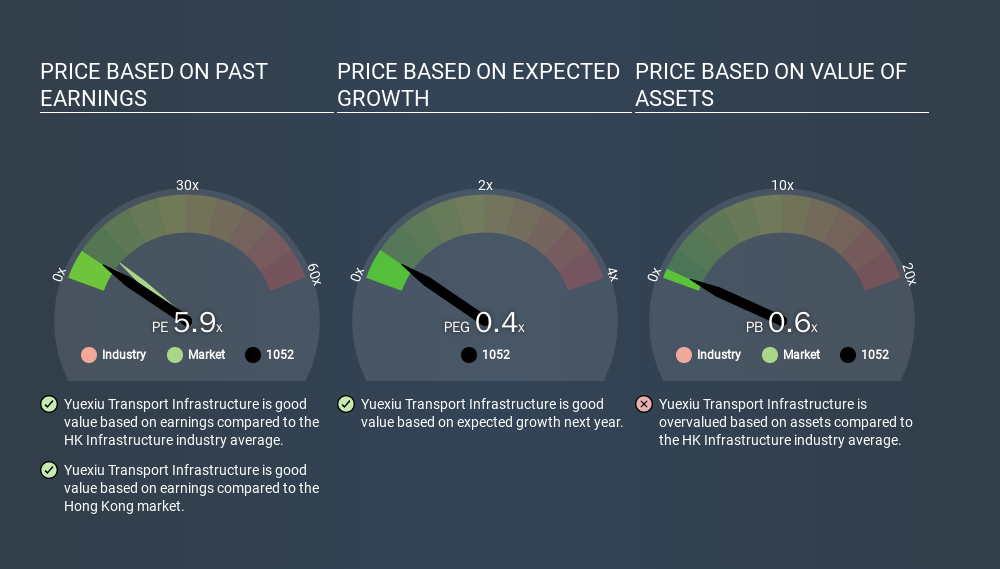- Hong Kong
- /
- Infrastructure
- /
- SEHK:1052
A Sliding Share Price Has Us Looking At Yuexiu Transport Infrastructure Limited's (HKG:1052) P/E Ratio

To the annoyance of some shareholders, Yuexiu Transport Infrastructure (HKG:1052) shares are down a considerable 35% in the last month. The recent drop has obliterated the annual return, with the share price now down 30% over that longer period.
All else being equal, a share price drop should make a stock more attractive to potential investors. While the market sentiment towards a stock is very changeable, in the long run, the share price will tend to move in the same direction as earnings per share. So, on certain occasions, long term focussed investors try to take advantage of pessimistic expectations to buy shares at a better price. One way to gauge market expectations of a stock is to look at its Price to Earnings Ratio (PE Ratio). A high P/E ratio means that investors have a high expectation about future growth, while a low P/E ratio means they have low expectations about future growth.
See our latest analysis for Yuexiu Transport Infrastructure
How Does Yuexiu Transport Infrastructure's P/E Ratio Compare To Its Peers?
Yuexiu Transport Infrastructure's P/E of 5.90 indicates relatively low sentiment towards the stock. If you look at the image below, you can see Yuexiu Transport Infrastructure has a lower P/E than the average (6.6) in the infrastructure industry classification.

Yuexiu Transport Infrastructure's P/E tells us that market participants think it will not fare as well as its peers in the same industry. While current expectations are low, the stock could be undervalued if the situation is better than the market assumes. You should delve deeper. I like to check if company insiders have been buying or selling.
How Growth Rates Impact P/E Ratios
Probably the most important factor in determining what P/E a company trades on is the earnings growth. If earnings are growing quickly, then the 'E' in the equation will increase faster than it would otherwise. And in that case, the P/E ratio itself will drop rather quickly. So while a stock may look expensive based on past earnings, it could be cheap based on future earnings.
Yuexiu Transport Infrastructure's earnings per share grew by 7.9% in the last twelve months. And it has bolstered its earnings per share by 13% per year over the last five years.
Don't Forget: The P/E Does Not Account For Debt or Bank Deposits
Don't forget that the P/E ratio considers market capitalization. In other words, it does not consider any debt or cash that the company may have on the balance sheet. The exact same company would hypothetically deserve a higher P/E ratio if it had a strong balance sheet, than if it had a weak one with lots of debt, because a cashed up company can spend on growth.
Such expenditure might be good or bad, in the long term, but the point here is that the balance sheet is not reflected by this ratio.
Yuexiu Transport Infrastructure's Balance Sheet
Yuexiu Transport Infrastructure's net debt is considerable, at 233% of its market cap. This level of debt justifies a relatively low P/E, so remain cognizant of the debt, if you're comparing it to other stocks.
The Bottom Line On Yuexiu Transport Infrastructure's P/E Ratio
Yuexiu Transport Infrastructure trades on a P/E ratio of 5.9, which is below the HK market average of 8.9. The meaningful debt load is probably contributing to low expectations, even though it has improved earnings recently. What can be absolutely certain is that the market has become more pessimistic about Yuexiu Transport Infrastructure over the last month, with the P/E ratio falling from 9.1 back then to 5.9 today. For those who prefer invest in growth, this stock apparently offers limited promise, but the deep value investors may find the pessimism around this stock enticing.
Investors have an opportunity when market expectations about a stock are wrong. If the reality for a company is not as bad as the P/E ratio indicates, then the share price should increase as the market realizes this. So this free visualization of the analyst consensus on future earnings could help you make the right decision about whether to buy, sell, or hold.
Of course, you might find a fantastic investment by looking at a few good candidates. So take a peek at this free list of companies with modest (or no) debt, trading on a P/E below 20.
If you spot an error that warrants correction, please contact the editor at editorial-team@simplywallst.com. This article by Simply Wall St is general in nature. It does not constitute a recommendation to buy or sell any stock, and does not take account of your objectives, or your financial situation. Simply Wall St has no position in the stocks mentioned.
We aim to bring you long-term focused research analysis driven by fundamental data. Note that our analysis may not factor in the latest price-sensitive company announcements or qualitative material. Thank you for reading.
About SEHK:1052
Yuexiu Transport Infrastructure
Invests in, constructs, develops, operates, and manages expressways and bridges in the People’s Republic of China.
Average dividend payer and fair value.
Market Insights
Community Narratives



